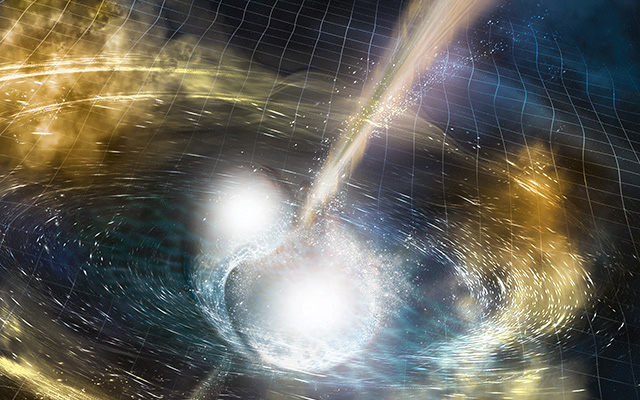
SDSC’s ‘Comet’ Supercomputer Assists in Latest LIGO Discovery
NSF-funded petascale system aids astrophysicists via the Open Science Grid
Published Date
By:
- Jan Zverina
Share This:
Article Content
The National Science Foundation (NSF) announcement in early 2016 that scientists for the first time detected gravitational waves in the universe as hypothesized by Albert Einstein in 1915 has led to additional landmark discoveries with the assistance of advanced supercomputers, including Comet at the San Diego Supercomputer Center (SDSC) at UC San Diego.
The NSF-funded Laser Interferometer Gravitational-Wave Observatory (LIGO), which recently earned three researchers the 2017 Nobel Prize in Physics for their initial findings in late 2015, announced earlier this week that scientists have now directly detected gravitational waves, or ripples in space-time, in addition to light from the spectacular collision of two neutron stars.
This marks the first time that a cosmic event has been viewed in both gravitational waves and light, according to LIGO researchers. A short video by LIGO describes the new findings.
The latest observations have also given astronomers around the world an unprecedented opportunity to pick up the signal and probe a collision of two neutron stars. The discovery was made using LIGO’s detectors as well as the Europe-based Virgo detector and some 70 other ground- and space-based observatories after LIGO alerted them about the event, which occurred long ago and only reached Earth last August after traveling some 130 million light years through space. One light year equals almost 6 trillion miles.
For example, observations made by the U.S. Gemini Observatory, the European Very Large Telescope, and the Hubble Space Telescope revealed signatures of recently synthesized material, including gold and platinum, solving a decades-long mystery of where about half of all elements heavier than iron are produced, according to the LIGO announcement.
SDSC’s Comet was one of several advanced high-performance computing (HPC) systems used to help confirm this newest finding, as well as the initial discovery. Comet is also funded by the NSF, and reflects a commitment by SDSC to support high-throughput computing (HTC) on national systems for large experimental facilities that started with SDSC’s support of large-scale data analysis for the Large Hadron Collider using the Gordon supercomputer several years ago.
“We’re especially proud that Comet is assisting LIGO researchers, and we look forward to offering this system and future ones, along with SDSC’s high-throughput computing expertise, to the LIGO project,” said SDSC Director Michael Norman, who also is the Principal Investigator for the Comet program. “As an astrophysicist myself, it is gratifying to see this extremely collaborative research community tackle science’s grand challenges related to extreme cosmic events.”
Two Million Hours
As before, LIGO researchers benefited from high-throughput computing via Comet and the Open Science Grid, a multi-disciplinary research partnership specializing in large-scale computing services funded by the U.S. Department of Energy and the NSF. OSG provided access to several advanced HPC systems, including Comet, for LIGO researchers to verify their findings.
“LIGO researchers have so far consumed more than 2 million hours of computational time on Comet through OSG – including about 630,000 hours each to help verify LIGO’s findings in 2015 and the current neutron star collision – using Comet’s Virtual Clusters for rapid, user-friendly analysis of extreme volumes of data,” said Frank Würthwein, a UC San Diego physics professor who leads SDSC’s distributed high-throughput computing activities and also serves as OSG’s executive director.
Added Würthwein: “LIGO researchers use many HPC resources of course, but among those accessed via OSG and the NSF’s Extreme Science and Engineering Discovery Environment (XSEDE), Comet was the top resource used based on hours of computational time.”
Comet was used to perform a full analysis and verification of the signal, according to Duncan Brown, a LIGO collaborator and The Charles Brightman Professor of Physics at Syracuse University’s Department of Physics who studies gravitational waveforms for black hole and neutron star binaries. “Comet’s contribution through the OSG and XSEDE allowed us to rapidly turn around the offline analysis in about a day,” said Brown. “That in turn allowed us to do several one-day runs, as opposed to having to spend several weeks before publishing our findings.”
Share This:
You May Also Like
Stay in the Know
Keep up with all the latest from UC San Diego. Subscribe to the newsletter today.



